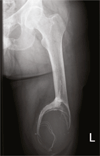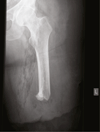Progressive ossification due to retained surgical sponge after upper leg amputation: a case report
- PMID: 20184688
- PMCID: PMC2827071
- DOI: 10.1186/1757-1626-0002-0000008592
Progressive ossification due to retained surgical sponge after upper leg amputation: a case report
Abstract
Introduction: Numerous cases are described of patients in whom foreign objects were found after surgery. Foreign body granuloma caused by retained surgical sponge, also called gossypiboma, mostly occur in the abdominal cavity but very seldom in limbs.
Case presentation: A 29-year-old Caucasian man presented with asymmetrical walking pattern and progressive pain in his leg, which was severely injured and amputated seven years before. A firm swelling of soft tissue with calcifications was localized in the stump. Roentgenogram and MRI showed a retained surgical sponge with calcifications. Open surgery was performed and a well-encapsulated, brownish soft-tissue tumour containing serous fluid was found in which the remnants of a surgical sponge of 40 x 40 centimeters was identified and removed. Infectious complications characterized the postoperative course for which multiple surgical procedures were needed to create a definitive healing of the stump.
Conclusion: A surgical sponge left behind in an amputated leg may lead to fibroma, destruction, osteolysis and calcification. In our case the gauze lead to mild dysfunction of the prosthetic leg, asymmetrical walking pattern, phantom pain and calcification and osteolysis on roentgenogram.
Figures
Similar articles
-
Gossypiboma: Spontaneous trans-urethral migration of a forgotten surgical gauze sponge 5 years post hysterectomy in grand multiparous post-menopausal woman.Int J Surg Case Rep. 2020;71:168-171. doi: 10.1016/j.ijscr.2020.04.104. Epub 2020 May 19. Int J Surg Case Rep. 2020. PMID: 32470912 Free PMC article.
-
Leg textiloma. A case report.Med Princ Pract. 2006;15(4):312-5. doi: 10.1159/000092998. Med Princ Pract. 2006. PMID: 16763402
-
Giant gossypiboma presenting as a pelvic mass.Radiol Case Rep. 2021 Aug 26;16(11):3308-3310. doi: 10.1016/j.radcr.2021.07.075. eCollection 2021 Nov. Radiol Case Rep. 2021. PMID: 34484537 Free PMC article.
-
A 13-year-old textiloma (gossypiboma) after discectomy for lumbar disc herniation: a case report and review of the literature.Spine J. 2007 Sep-Oct;7(5):618-21. doi: 10.1016/j.spinee.2006.08.004. Epub 2007 Feb 12. Spine J. 2007. PMID: 17905325 Review.
-
[Gossypiboma after abdominal surgery is a challenging clinical problem and a serious medicolegal issue].Arq Bras Cir Dig. 2013 Jun;26(2):140-3. doi: 10.1590/s0102-67202013000200015. Arq Bras Cir Dig. 2013. PMID: 24000029 Review. Portuguese.
Cited by
-
A usual cause of tumoural mass of the index finger.BMJ Case Rep. 2014 May 19;2014:bcr2014204248. doi: 10.1136/bcr-2014-204248. BMJ Case Rep. 2014. PMID: 24842364 Free PMC article.
-
Extremity gossypiboma mimicking sarcoma: case report and review.Skeletal Radiol. 2019 Apr;48(4):629-635. doi: 10.1007/s00256-018-3059-5. Epub 2018 Sep 10. Skeletal Radiol. 2019. PMID: 30203183
-
Gossypiboma in Thigh- A Case Report.J Orthop Case Rep. 2014 Jul-Sep;4(3):22-4. doi: 10.13107/jocr.2250-0685.188. J Orthop Case Rep. 2014. PMID: 27298975 Free PMC article.
-
Infected Textiloma, 35 Years after the Operation for Femur Fracture, an extermly rare occurance.Arch Bone Jt Surg. 2013 Sep;1(1):41-3. Epub 2013 Sep 15. Arch Bone Jt Surg. 2013. PMID: 25207284 Free PMC article.
References
LinkOut - more resources
Full Text Sources




